
Current measurement results in 5V and 12V branches of HDDs and SSDs.
Currently, there are miniature platforms with SATA connectors that allow you to build many interesting devices equipped with capacious and fast hard drives. We checked the current consumption of HDDs and SSDs, the information may be useful for you when building a home NAS or other device equipped with a SATA connector. The type of disk selected will affect both the power consumption of the device, but also the type of power supply required or the battery life (e.g. during a power outage or operating as a portable device). Regardless of whether you want to replace the disk in your laptop or use a hard disk in your design, it is worth choosing its type well.
In short, the results can be viewed in the video below or read more later in the article.
Accepted measurement principles.
To measure the current in the 5V and 12V branches, multimeters were used, set to measure direct current at the maximum range. By accepting a lower resolution and accuracy, we obtain a low internal resistance of the ammeter, thanks to which we have little interference with the hard disk (voltage drop). The voltages on the 5V and 12V rails were 5.13V and 12.15V, respectively.
The current consumption was measured for:
-state of inactivity (idle)
-state of sequential write
- sequential read status (seq read)
-search status / access time (seeking)
Measurements were made using the maximum capacity of the disk (eg checking the maximum read / write speed), the power consumption in "quieter" operation may be lower.
We will check whether the power consumed by the disk depends on the operations it performs. Current values have been rounded to two decimal places, power consumption values to one decimal place.
Additionally, we checked the shape of the current waveform in the supply branches with the use of an oscilloscope measuring the voltage drop across a 0.1? resistor, which was included in the tested branch. Channel sensitivity was set to 50mV / div for all measurements.
The test was selected from modern and older disk models, 2.5 "and 3.5", dedicated to NAS / RAID solutions, as well as popular "laptop" drives.
As far as possible, disks of one manufacturer / product lines of disks were selected for the test. The disks were provided by those interested in taking such a measurement, we do not have unlimited resources, also the disk models are somewhat random ...
HDD 3.5 "dedicated to work in SATA NL class RAID.
| type of disk | test | result of the test | branch current 12V | branch current 5V | power | comments |
| WD RE4 2TB | idle | - | 0.58A | 0.35A | 8.8W | starting current ~ 1.8A |
| WD RE4 2TB | seq write | 125MB / s | 0.55A | 0.80A | 10.8W | |
| WD RE4 2TB | seq read | 126MB / s | 0.55A | 0.75A | 10.5W | |
| WD RE4 2TB | seeking | 12ms | 0.76A | 0.42A | 11.4W | |
| WD RE 1TB | idle | - | 0.37A | 0.17A | 5.4W | prąd podczas startu ~1.8A |
| WD RE 1TB | seq write | 128MB/s | 0.37A | 0.72A | 8.2W | |
| WD RE 1TB | seq read | 120MB/s | 0.36A | 0.65A | 7.7W | |
| WD RE 1TB | seeking | 12ms | 0.56A | 0.32A | 8.4W | |
| Seagate ES.2 1TB | idle | - | 0.51A | 0.31A | 7.8W | dość stary model |
| Seagate ES.2 1TB | seq write | 99MB/s | 0.51A | 0.75A | 10W | |
| Seagate ES.2 1TB | seq read | 97MB/s | 0.51A | 0.68A | 9.7W | |
| Seagate ES.2 1TB | seeking | 13ms | 0.51A | 0.4A | 8.2W |
In the case of HDD NL SATA, the power consumption fluctuates around 10W and may depend on the operations performed (it can reach 5W when idle). The higher the capacity, the higher the current consumption. Quite high power consumption during device start-up, in a matrix based on many disks, it is necessary to predict a greater demand for electricity at start-up and intensive work.
HDD dedicated to work in home NAS.
| type of disk | test | result of the test | branch current 12V | branch current 5V | power | comments |
| WD RED 1TB 3.5 " | idle | - | 0.17A | 0.25A | 3.4W | łagodny start |
| WD RED 1TB 3.5" | seq write | 95MB/s | 0.16A | 0.46A | 4.3W | |
| WD RED 1TB 3.5" | seq read | 96MB/s | 0.16A | 0.46A | 4.3W | |
| WD RED 1TB 3.5" | seeking | 22ms | 0.26A | 0.28A | 4.6W | |
| WD RED 750G 2.5" | idle | - | 0A | 0.3A | 1.5W | no current consumption in the 12V branch |
| WD RED 750G 2.5 " | seq write | 95MB / s | 0A | 0.6A | 3.1W | |
| WD RED 750G 2.5 " | seq read | 106MB / s | 0A | 0.5A | 2.6W | |
| WD RED 750G 2.5 " | seeking | 17ms | 0A | 0.4A | 2.1W |
You can see optimization for low power consumption, drives in the 2.5 "version usually do not require a 12V power supply and consume less current.
Let's see what the shape of the current consumed while writing by the 3.5 "WD RED 1TB drive looks like.
5V bus:
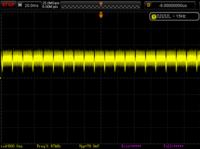
You can see changes in the current consumption depending on the operations performed, the peak current reaches 0.8A, the minimum current is about 100mA. You can see the impact of the drive's operation on the current consumption in the 12V branch:
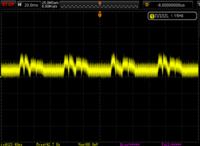
Read operations cause similar changes in current consumption (5V branch):

2.5 "" laptop "drives.
| type of disk | test | result of the test | branch current 12V | branch current 5V | power | comments |
| HGST 0.5T Travelstar Z7K500 | idle | - | 0A | 0.17A | 0.9W | 7200 rpm |
| HGST 0.5T | seq write | 135MB / s | 0A | 0.6A | 3.1W | |
| HGST 0.5T | seq read | 122MB/s | 0A | 0.58A | 3W | |
| HGST 0.5T | seeking | 16ms | 0A | 0.5A | 2.6W | |
| WD SCORPIO 320G | idle | - | 0A | 0.25A | 1.3W | |
| WD SCORPIO 320G | seq write | 61MB/s | 0A | 0.57A | 2.9W | |
| WD SCORPIO 320G | seq read | 54MB/s | 0A | 0.4A | 2.1W | |
| WD SCORPIO 320G | seeking | 18ms | 0A | 0.38A | 2W | |
| Seagate momentus 500GB | idle | - | 0A | 0.1A | 0.5W | |
| Seagate momentus 500GB | seq write | 53MB/s | 0A | 0.45A | 2.3W | |
| Seagate momentus 500GB | seq read | 101MB / s | 0A | 0.45A | 2.3W | |
| Seagate momentus 500GB | seeking | 18ms | 0A | 0.4A | 2.1W |
2.5 "" laptop "drives show low power consumption and no power consumption in the 12V branch.
Shape of current consumption during recording:
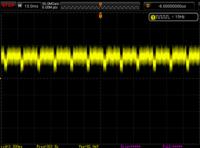
and reading:
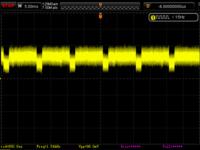
is characteristic of magnetic disks.
The current consumption can be reduced by giving the disk a stop command. It takes time for the drive to come to a running state from a stopped state.
Stopped power consumption:
| type of disk | current consumption 12V | current consumption 5V | power |
| WD RED 1TB 3.5 " | 0A | 0.17 | 0.9W |
| WD RED 750GB 2.5 " | 0A | 0.09A | 0.5W |
| HGST 500GB 2.5 " | 0A | 0.06A | 0.3W |
| WD SCORPIO 320GB 2.5 " | 0A | 0.08A | 0.4W |
2.5 "SSD disks.
| type of disk | test | result of the test | branch current 12V | branch current 5V | power | comments |
| Kingston 64GB SSD | idle | - | 0A | 0.25A | 1.3W | starszy model większy prąd |
| Kingston 64GB SSD | seq write | 92MB/s | 0A | 0.6A | 3.1W | |
| Kingston 64GB SSD | seq read | 165MB/s | 0A | 0.5A | 2.6W | |
| Kingston 64GB SSD | seeking | 0.2ms | 0A | 0.3A | 1.5W | |
| Kingston 128GB SSD | idle | - | 0A | 0.07A | 0.4W | |
| Kingston 128GB SSD | seq write | 104MB/s | 0A | 0.5A | 2.6W | |
| Kingston 128GB SSD | seq read | 168MB/s | 0A | 0.4A | 2.1W | |
| Kingston 128GB SSD | seeking | 0.2ms | 0A | 0.3A | 1.5W | |
| GoodRAM 240GB SSD | idle | - | 0A | 0.01A | 0.1W | |
| GoodRAM 240GB SSD | seq write | 198MB/s | 0A | 0.58A | 3W | |
| GoodRAM 240GB SSD | seq read | 394MB/s | 0A | 0.47A | 2.4W | |
| GoodRAM 240GB SSD | seeking | 0.08ms | 0A | 0.2A | 1W |
In the case of SSD drives, the visible advantage is the low power consumption during idle time (as well as short access time and high read and write speed).
SSD technology is advancing, capacity is increasing, power consumption is lowered, bandwidth is increasing, and access time is lowered.
The shape of the current in the 5V line when writing for the GoodRAM disk:
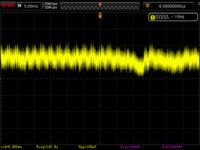
Shape of the current when reading:

Current cycles are faster than magnetic disks.
During the waiting state, you can see cyclical increases in power consumption (internal disk controller work, or maybe an internal pulse converter?):
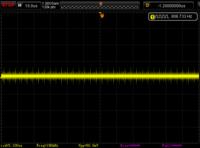
Have you come across interesting experiences while selecting hard drives, maybe you will present the results of your own measurements?
Part II - More accurate measurements and comparison of SSD and HDD power consumption at lower than maximum write speeds.
Cool? Ranking DIY





